Queer Cinema, LOVE, SIMON & The Problem Of Heterosexual Spectatorship
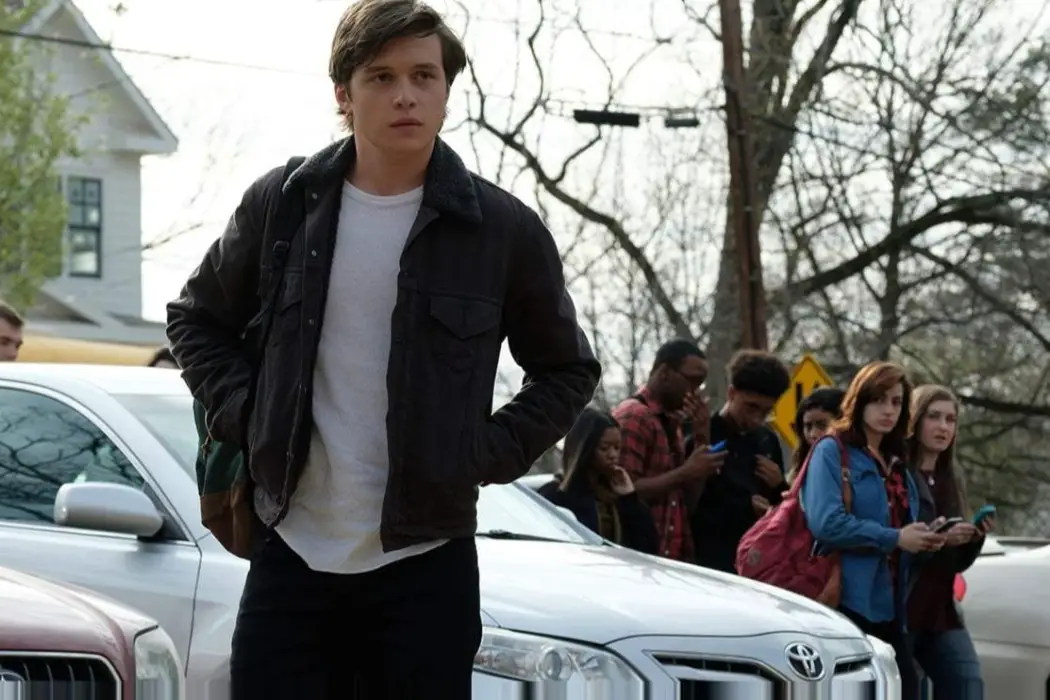
Tessa is a writer living in Boston, where she spends…
I am sitting in a theater, watching Love, Simon, and leaving my body. Over the course of the movie, my body language has shifted in phases; when I first took my seat next to my girlfriend, I draped her arm around my shoulder, tucked my legs under myself, and faced the screen. By the forty-five minute mark, I had turned my body one degree away from the screen for every minute of the film, so I was curled toward my girlfriend and could direct half my attention toward her reactions. By the final scene, I have developed a twitch, and I’m watching the climax with one eye open.
If Love, Simon was making a more self-reflexive point, this is where I’d suggest my bodily reaction was appropriately calibrated to the narrative’s concern with spectatorship, and my instinct to shift away from the screen effectively matched moments when the idea of witnessing intimacy became uncomfortable. After all, my two moments of greatest agitation occur during scenes where characters are forced to do or say something publicly, in front of an audience.
First, in a scene where the socially inept Martin insists that Abby (a friend of Simon’s, for whom Martin nurses a crush) shouts an affirmation about herself in a waffle house, despite her clear resistance; and secondly in the climactic scene, in which a huge group of Simon’s classmates gathers around to watch him meet his love interest for the first time. Maybe this is expecting too much, but it’s a shame. There’s a lot to be said on the theme of violated intimacy in gay relationships, and Love, Simon says most of it by accident.
Love, Simon in a Nutshell
For those who haven’t seen the film or read the Becky Albertalli young adult novel from which it derives, the plot is pretty straightforward (spoilers follow): Simon is a white, upper-middle class high school senior, putting off the awkwardness of coming out to his family and friends. This is fairly low stakes until another closeted student, using the pseudonym Blue, posts a confession online, and the two boys strike up an anonymous email correspondence.
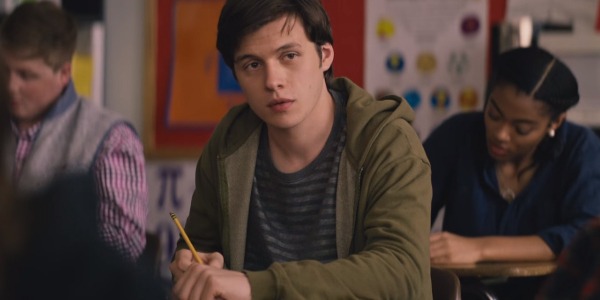
They begin developing feelings for one another, but when Simon is publicly outed by a classmate, Blue is shaken and breaks off the emails. Simon uses his online platform to ask Blue for another chance, and, in a classic rom-com finale, the two are united on a ferris wheel, sharing a kiss while their classmates look on a cheer.
Rom-com history and inspiration
Many reviewers have made the obvious rom-com connection, likening Love, Simon to the champion of anonymous email romance, You’ve Got Mail – but Love, Simon has been updated for 2018 in more ways than its same-gender love story. Unlike 1998’s You’ve Got Mail, which is set in a world where meeting someone via chat room is unconventional and embarrassing, Love, Simon foregrounds the prevalence of social media to show how quickly high school gossip can spread.
Simon and Blue’s romance is structured around moments of public scrutiny; their introduction, digital breakup, and the beginning of their offline relationship are all prompted through public (and publicized) declarations. In other words, this is a romance that comes equipped with an in-world audience, present even before the filmgoers sit down.
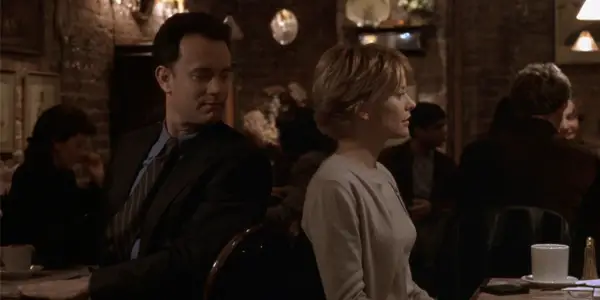
Forming a romance online might make Blue and Simon especially visible, but ultimately, this is just a contemporary twist on a trope as old as the romantic comedy genre itself. Rom-coms make private moments public, positing exhibition as the purest form of love. When we’re in love, according to rom-coms, we burst into board meetings, holiday parties, and restaurants. During these “grand gesture” scenes, the film viewers get to occupy multiple roles; sympathizing with the couple, and aww-ing along with the backgrounds characters who exist only to witness this romantic eruption.
The beautiful thing about romantic movies is that we are being called upon to witness love, and if the film also includes a grand gesture in front of other characters (if it’s a rom-com, it probably does), our position as spectator is sanctioned by the narrative. If minor characters are allowed to watch the couple kiss, it’s certainly fine if the audience stares; and as long as the audience is cooing, there’s no reason to suggest the other characters shouldn’t be cooing, too.
This logic is necessary to hold together the feel-good optimism of a heterosexual rom-com. But does it make equal sense when applied to a gay romance? For me, this trope of public declaration marks the exact limit of Simon’s “I’m just like you” appeal. I’m not convinced a gay love story fits comfortably into a narrative that relies on a willingness to be seen and applauded by straight people. As long as we’re unwilling to relinquish the idea that public pressure can justifiably ensure romantic compliance, gay characters in rom-coms will be put in an uneasy position.
Pre-existing tropes aren’t always good choices
Watching characters be pressured into love isn’t the most comfortable part of the average rom-com to begin with. This is everywhere: Kat resisting Patrick’s advances until her sister begs her to reconsider in 10 Things I Hate About You; Joe using his two personas to convince Kathleen that putting her out of business wasn’t a big deal in You’ve Got Mail; Allie screaming “All right, I’ll go out with you!” from the top of a ferris wheel in The Notebook, as Noah dangles one-handed, threatening to let go if she doesn’t acquiesce.
Romantic coercion is already troublesome, but it’s particularly abrasive in a coming out narrative, where the decision to pursue a romance may also represent a change in how your community sees and treats you. Rather than engaging with the delicacy and tenderness of this moment, Love, Simon falls back on traditionally heterosexual tropes, until Simon essentially gives Blue an ultimatum: out yourself to the whole town, or cut off communication with the one gay person with whom you have shared a connection.
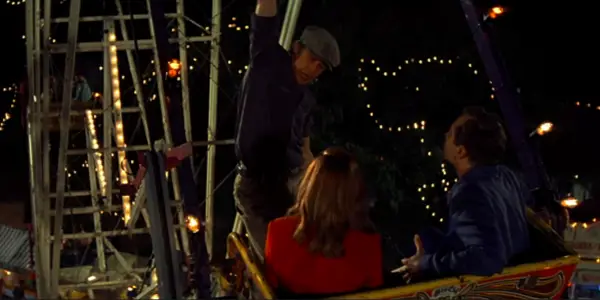
Over the course of the film, Blue has repeatedly, explicitly told Simon that he doesn’t feel ready to fully come out, and is working through telling his family at his own pace. This ought to make sense to Simon; he has already been outed by Martin, and, in a cathartic scene, shouted that coming out should have been his choice, done on his terms, when he was ready. Yet Simon puts Blue in precisely the same position when he announces his intention to attend the local fair and ride the ferris wheel until Blue joins him (at this point, I do feel obligated to note that the cinematic ending is different than the ending in the novel – this intensely public meetup is very much a decision of the adaptation).
Pressuring Blue to out himself feels cruel, and I feel cruel watching it. I feel especially aligned with cruelty because Simon and Blue are not alone, but surrounded with straight classmates (with the one exception of Ethan, a fashion-oriented, openly gay black student to whom, it is made clear, Simon can’t possibly relate). Simon and Blue’s straight classmates gather around the ferris wheel, literally pulling out iPhones and filming the two boys as they share their first kiss. Mysteriously, these seem to be the benevolent onlookers to whom we in the audience are meant to relate.
This is a grand gesture that imagines self-acceptance is synonymous with allowing straight people to gawk at you, and I cannot trick my brain into seeing that as a romantic triumph. Shifting heterosexual tropes onto a gay story is not always a simple conversion, especially when these tropes are complicated by a gay character’s social security, privacy, and safety. Love, Simon’s romantic finale assumes certain narratives are universal, but I no longer think this is the direction gay cinema should be moving.
If the bones of a genre have been delineated to accommodate straight stories, and if we want to see more same-gender rom-coms in the future (which I do, badly), let’s take the opportunity to reexamine familiar tropes and consider whether they are appropriate to the stories we are telling. Otherwise, we end up with scenes that feel fetishistic rather than validating.
Watching the ferris wheel scene in the theater, I feel my girlfriend’s arm heavy around my shoulder. We both know what it’s like to be visible in public, and especially what it’s like to be seen by heterosexual eyes. As a woman, I most frequently see this phenomenon (I can only think to describe it as the heterosexual gaze) used to hypersexualize – but Love, Simon is a teen movie, and it swivels hard in the other direction. The characters never come close to having sex, but the narrative climax feels exploitative in a similar way, with that same sense of heterosexual viewership steamrolling over the more organic gay perspective.
When I watch the ferris wheel scene, I am given two options: either distance myself from the gay point of view and adopt the perspective of the onlooking crowd, or continue to relate to the gay protagonist, and feel the heterosexual gaze boring into me. I fight the urge to crane my neck and check if anyone else looks uncomfortable. In a bizarre, kaleidoscopic moment, I drift out of my body and see myself seeing the other audience members, who are watching the straight characters on screen, who are looking at the gay characters, who are having a moment that’s supposed to be intimate. I’ve never been more conscious of my own viewership in a theater before, which would be an accomplishment if I thought it was intentional.
Looking to the future of gay genre films
I grew up hungry for gay films in every genre. At the time, it almost felt like a joke; a gay thriller might be a fun idea, but obviously it wasn’t going to happen, not while “gay” was a problem, and problems could only be solved in lifetime movies, or remain unsolved in dramas. But it’s 2018 now, and life looks different than it did when I was in highschool. One of my favorite movies from the past year is Thelma, and it’s exactly what I thought I would never see – a gorgeous, engaging, beautifully put-together supernatural thriller featuring a central lesbian romance that does not end in tragedy (or does it? Watch the movie!). Very recently, these things have started feeling possible.
I have had the time and inclination to build up a backlog of gay cinema, and seeking representation no longer feels desperate: The Incredibly True Story of Two Girls In Love came out twenty-two years ago; Gina Rodriguez’s lesbian energy in Annihilation knocked me flat for a week; we’ve got Carol, Moonlight, Pariah, The Way He Looks, all of which feature lovely coming of age stories with optimistic-at-minimum endings.
When you discover that foreign films and independent films can be watched for entertainment, it broadens the pool of movies you watch to such a degree that it becomes possible to decentralize Hollywood. It’s not that foreign films are oh-so-daring, it’s just that Hollywood is not. I’m ready to discuss movies for what they accomplish as pieces of art, rather than cutting off the conversation if they aim for any degree of social good.
Even with this being said, there’s still a lot I like in Love, Simon. A handful of jokes make me laugh out loud, the rare moments in which the love story actually develops are cute (cuter upon a second viewing, when you can ignore the red herrings of Blue’s potential identities), and it’s fun to see a coming out narrative in which the protagonist doesn’t doubt his identity or hate himself. Even now, part of me hesitates to voice my opinion because I so want to see this film for the good it is doing. But how depressing to engage less critically for fear of discouraging future representation, as if Hollywood is a scared animal who needs to be coaxed out of the shadows.
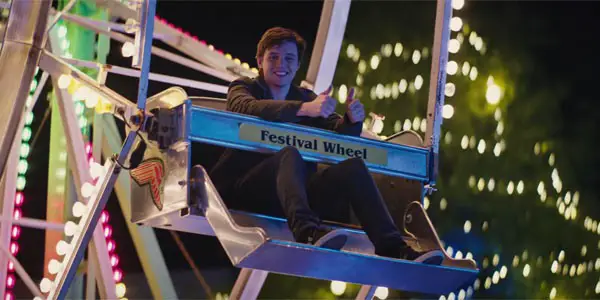
In my skepticism, I am trying to imagine what it would feel like to watch Love, Simon as a 13-year-old, hidden under my covers at night, clicking through a 480p YouTube playlist of videos with titles like “LS 2018 full movie p19 (dont comment the title!!)” Furtive investigation into gay cinema made me feel like a junior anthropologist, piecing together a culture and history that I could sense, but didn’t have the context to fully understand.
Regardless of likes and dislikes, would I have been so critical of this movie at that age? Probably not. I was looking for something different in those days: not cinematic mastery, but just proof of existence, Sasquatch tracks that could lead somewhere else. But time only goes in one direction, and I’ve gotten used to seeing myself as the protagonist in my own story.
But I shouldn’t assume that when young closeted people watch movies under the covers at night, we’re looking for the same thing. Maybe this movie is exactly what viewers want: something innocuous, something that prioritizes normalization above engagement with the specific vibrancy of falling in love outside of preexisting tropes. The gay rom-com of my dreams doesn’t care if straight people like it or not, but then, the gay rom-com of my dreams has no teachable angle or purpose except to be loved by me.
I truly hope this movie lands with closeted teens who love it. I hope they love it so much they demand more, and better. But for me, this turns the question back on the audience: are we ready to become active viewers?
Can we find a way to discuss gay narratives without implying that criticism invalidates anything positive about the films being made?
Does content like this matter to you?
Become a Member and support film journalism. Unlock access to all of Film Inquiry`s great articles. Join a community of like-minded readers who are passionate about cinema - get access to our private members Network, give back to independent filmmakers, and more.
Tessa is a writer living in Boston, where she spends her time eating falafel and falling asleep on public transportation. Her greatest personal goal is to learn how to allow someone to dislike horror films without trying to convince them they just haven't seen the good ones yet.












